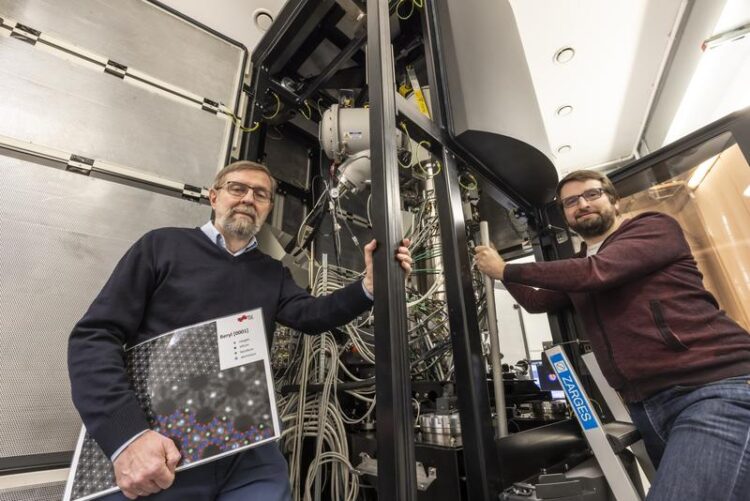New Method for Analysing Nanoporous Materials

Ferdinand Hofer (left) and Daniel Knez next to the Austrian Scanning Transmission Electron Microscope (ASTEM) at the Institute of Electron Microscopy and Nanoanalytics at TU Graz.
(c) Helmut Lunghammer - TU Graz
Using only a single electron microscope image, researchers at TU Graz can determine the type and exact position of so-called guest atoms in high-tech materials. They also come closer to solving the mystery of the blue colour of aquamarine.
In addition to their main components, the properties of crystalline and nanoporous materials often depend crucially on guest atoms or ions that are embedded in the tiny pores of their lattice structure. This applies to high-tech materials used in sensor or separation technology as well as to natural materials. The bluish gemstone aquamarine, for example, would be colourless without such guest components. Determining the type and position of guest components is difficult, as many materials react sensitively to the radiation emissions from electron microscopes. Thanks to a new method developed by a team led by Daniel Knez and Ferdinand Hofer at the Institute of Electron Microscopy and Nanoanalysis at Graz University of Technology (TU Graz), this can now be done with less radiation and is therefore much easier. “The uniqueness of our method lies in the fact that we can determine the three-dimensional distribution of ions in crystal channels or nanopores based on a single electron microscope image,” says Daniel Knez.
An electron microscope image of an aquamarine. The yellow arrows mark caesium ions in the crystal pores. (c) FELMI-ZFE / TU Graz
The mysterious blue colour of aquamarine
The researchers developed their method while analysing the gemstone aquamarine. Until now, it was not known where exactly the iron that lends the stone its blue colour is positioned in the crystal. One hypothesis was that individual iron atoms are stuck in the pores and create this effect from there. But this has now been refuted. In their experiments, the researchers have established beyond doubt that there is no iron in the pores, but instead caesium ions. The colour-conferring iron atoms are located in close proximity to the caesium ions, but are integrated into the columns of the crystal lattice.
A single image with atomic resolution as a basis
For their experiments, the researchers recorded a so-called Z-contrast image of the aquamarine crystal at atomic resolution using the ASTEM microscope, a scanning transmission electron microscope. The electron beam of the ASTEM microscope is focused on the surface of the crystal sample, also penetrating into the pores of the material. If it hits ions stored there, they appear as bright dots in the image. Based on the strength of the contrast with empty pores and the neighbouring lattice structures, the researchers can determine the type of embedded ions and also estimate how deep they are located in the pores. These data were statistically analysed and compared with a large number of simulations of the crystal structure in order to be able to estimate the various factors influencing the measured signal. The researchers recently published their findings in the journal Communications Materials.
Innovative method opens up new possibilities for materials science
In addition to basic research, the new method is also suitable for the targeted development of new materials. “Our method can be used to precisely determine the position of doping elements, i.e. targeted function-controlling additives, in nanoporous materials such as zeolites or metal-organic framework compounds,” says Ferdinand Hofer. This facilitates the optimisation of (single-atom) catalysts and solid-state electrolytes in future batteries or the development of biomedical applications for controlling drug uptake.
Wissenschaftliche Ansprechpartner:
Daniel KNEZ
Dipl.-Ing. Dr.techn. BSc
TU Graz | Institute of Electron Microscopy and Nanoanalysis
Phone: +43 316 873 8831
knez@tugraz.at
Ferdinand HOFER
Ao.Univ.-Prof.i.R. Dipl.-Ing. Dr.techn.
TU Graz | Institute of Electron Microscopy and Nanoanalysis
Phone: +43 316 873 8349
ferdinand.hofer@tugraz.at
Originalpublikation:
Three-dimensional distribution of individual atoms in the channels of beryl
In:
Communications Materials, 22 February 2024
Authors:
Daniel Knez, Christian Gspan, Nikola Šimić, Stefan Mitsche, Harald Fitzek, Karl Gatterer, Helmar Wiltsche, Gerald Kothleitner, Werner Grogger, Ferdinand Hofer
DOI: https://doi.org/10.1038/s43246-024-00458-8
Weitere Informationen:
https://www.tugraz.at/forschung/fields-of-expertise/advanced-materials-science/u… This research area is anchored in the Field of Expertise Advanced Materials Science, one of five strategic foci of TU Graz.
Media Contact
All latest news from the category: Materials Sciences
Materials management deals with the research, development, manufacturing and processing of raw and industrial materials. Key aspects here are biological and medical issues, which play an increasingly important role in this field.
innovations-report offers in-depth articles related to the development and application of materials and the structure and properties of new materials.
Newest articles

First-of-its-kind study uses remote sensing to monitor plastic debris in rivers and lakes
Remote sensing creates a cost-effective solution to monitoring plastic pollution. A first-of-its-kind study from researchers at the University of Minnesota Twin Cities shows how remote sensing can help monitor and…

Laser-based artificial neuron mimics nerve cell functions at lightning speed
With a processing speed a billion times faster than nature, chip-based laser neuron could help advance AI tasks such as pattern recognition and sequence prediction. Researchers have developed a laser-based…

Optimising the processing of plastic waste
Just one look in the yellow bin reveals a colourful jumble of different types of plastic. However, the purer and more uniform plastic waste is, the easier it is to…



